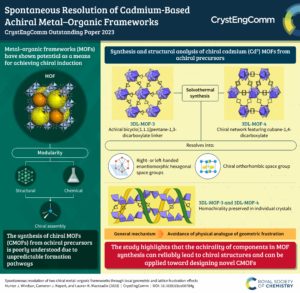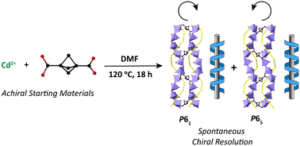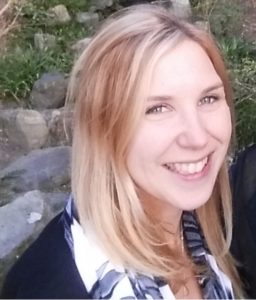 |
 |
|
|
Issue 47 – outside front cover |
Issue 47 – inside front cover |
|
 |
 |
|
|
Issue 45 – inside front cover |
Issue 46 – outside front cover |
Issue 46 – inside front cover |
 |
 |
|
|
Issue 43 – front cover |
Issue 44 – front cover |
Issue 45 – outside front cover |
 |
 |
|
|
Issue 40 – front cover |
Issue 41 – front cover |
Issue 42 – front cover |
 |
 |
|
|
Issue 36 – inside front cover |
Issue 38 – front cover |
Issue 39 – front cover |
 |
 |
 |
|
Issue 33 – outside front cover |
Issue 35 – outside front cover |
Issue 36 – outside front cover |
 |
 |
 |
|
Issue 30 – outside front cover |
Issue 31– outside front cover |
Issue 32– outside front cover |
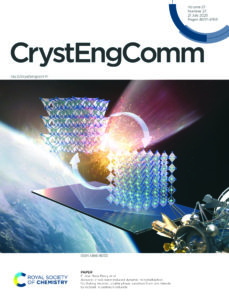 |
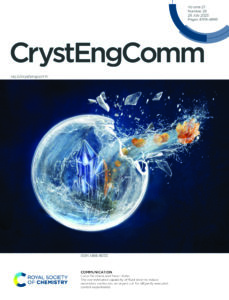 |
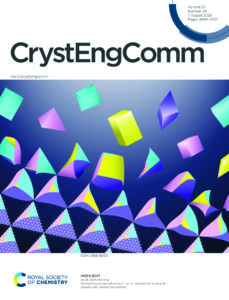 |
|
Issue 27 – outside front cover |
Issue 28– outside front cover |
Issue 29– outside front cover |
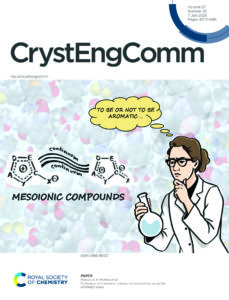 |
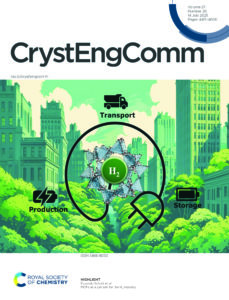 |
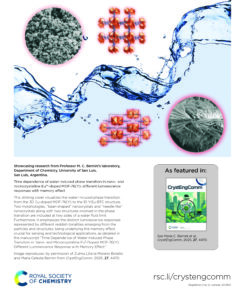 |
|
Issue 25 – outside front cover |
Issue 26 – outside front cover |
Issue 26 – outside back cover |
 |
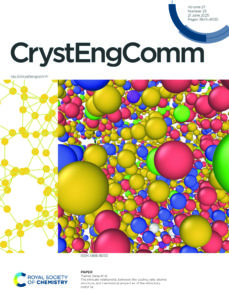 |
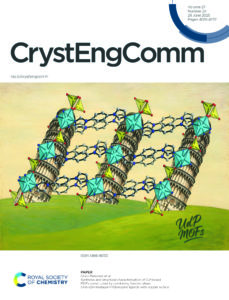 |
|
Issue 23 – outside front cover |
Issue 23 – inside front cover |
Issue 24 – outside front cover |
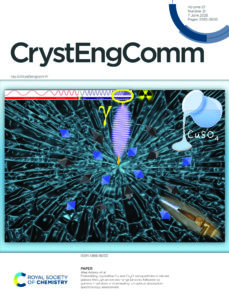 |
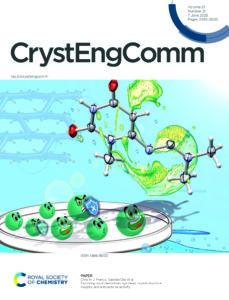 |
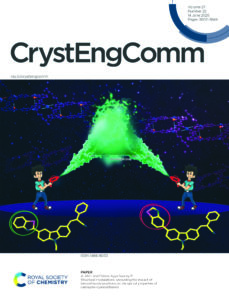 |
|
Issue 21 – outside front cover |
Issue 21 – inside front cover |
Issue 22 – outside front cover |
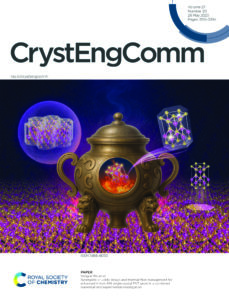 |
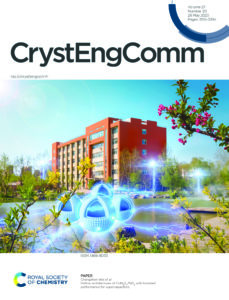 |
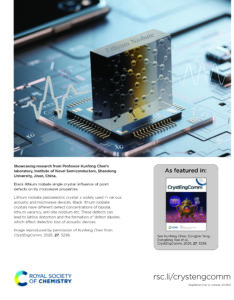 |
|
Issue 20 – outside front cover |
Issue 20 – inside front cover |
Issue 20 – outside back cover |
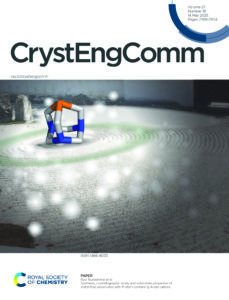 |
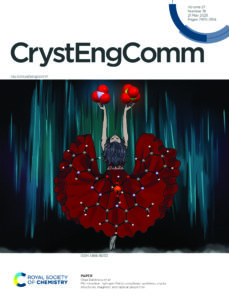 |
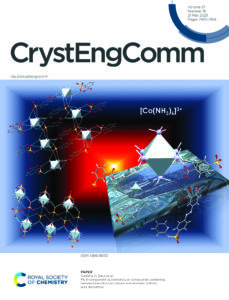 |
|
Issue 18 – inside front cover |
Issue 19 – outside front cover |
Issue 19 – inside front cover |
 |
 |
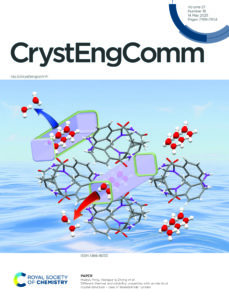 |
|
Issue 16 – back cover |
Issue 17 – front cover |
Issue 18 – outside front cover |
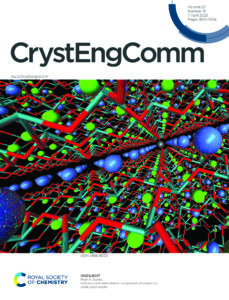 |
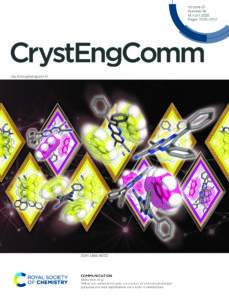 |
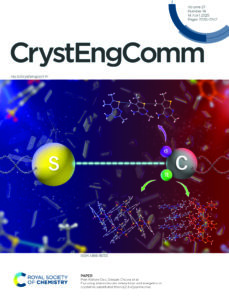 |
|
Issue 13 – inside front cover |
Issue 14 – outside front cover |
Issue 14 – inside front cover |
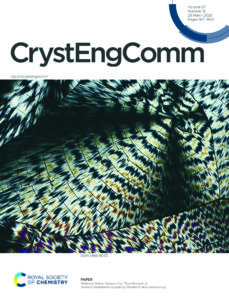 |
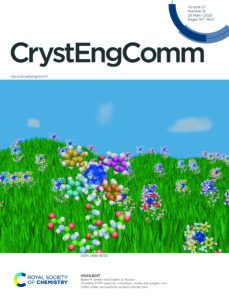 |
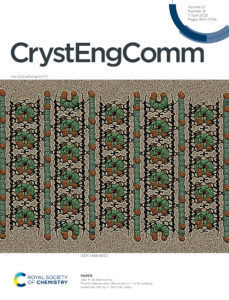 |
|
Issue 12 – outside front cover |
Issue 12 – inside front cover |
Issue 13 – outside front cover |
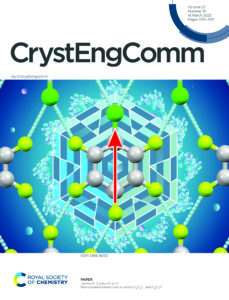 |
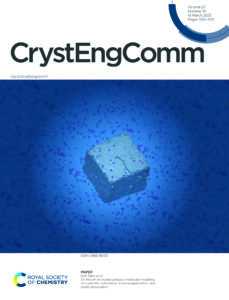 |
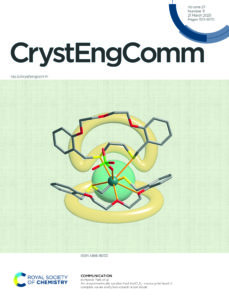 |
|
Issue 10 – outside front cover |
Issue 10 – inside front cover |
|
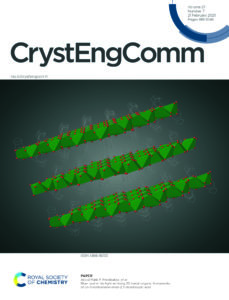 |
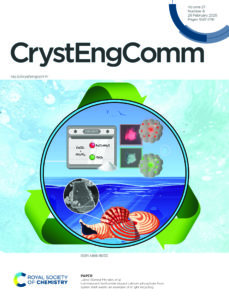 |
 |
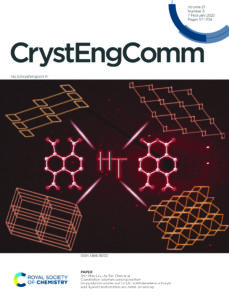 |
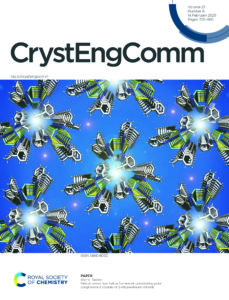 |
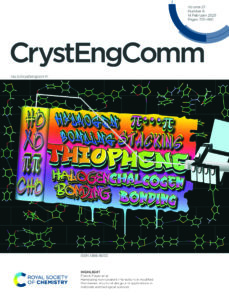 |
|
Issue 5 – inside front cover |
Issue 6 – outside front cover |
Issue 6 – inside front cover |
 |
 |
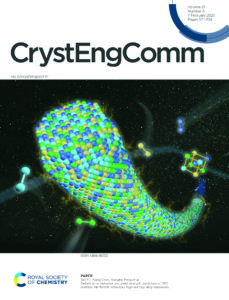 |
| Issue 4 | Issue 5 – outside front cover |
Author Archive
CrystEngComm 2025 Cover Gallery
Tutorial Review: Identifying and characterising flexible crystals
CrystEngComm Tutorial Reviews were first commissioned in 2024 and are aimed at researchers who are new to the field or are embarking on a new direction of research, giving insight into how crystal engineering techniques underpin certain research areas.
They are focused on the application of crystal engineering techniques and should be comprehensive enough to be used for teaching purposes. They comment on best practice techniques for a given research methodology and how understanding crystal engineering can best serve researchers’ progress on a given topic.
Each Tutorial Review includes up to five ‘key learning points’ that a reader should expect to gain from reading the review.
See our most recent Tutorial Review by Atiqur Rahman, John C. McMurtrie, Sajesh P. Thomas and Jack K. Clegg
|
Identifying and characterising flexible crystals Atiqur Rahman, John C. McMurtrie, Sajesh P. Thomas and Jack K. Clegg CrystEngComm, 2025, 27, 7110-7120 |
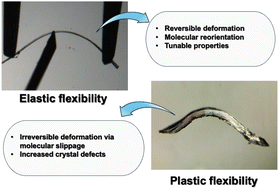 |
Key learning points in this Tutorial review:
1. Molecular crystals undergo two types of mechanical deformation—elastic (reversible) and plastic (irreversible)—each led by different structural features and intermolecular interactions.
2. Elastic flexibility is often driven by anisotropic interaction topologies and reversible molecular reorientations, whereas plasticity is facilitated by low-energy slip systems (often slip planes).
3. μ-XRD and μ-Raman mapping provide insight into structural changes and local internal stress distribution across the elastically bent crystals.
4. Mechanical deformation affects a range of material properties, including fluorescence, conductivity, and thermal behaviour, highlighting the multifunctionality of flexible crystals.
5. Classical models like Euler–Bernoulli theory are limited due to anisotropic and inhomogeneous deformations in crystals
6. Flexible molecular crystals are promising for next-gen technologies such as piezoelectric actuators and reconfigurable waveguides.
Meet the authors
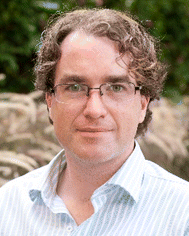 |
Professor Jack K. Clegg studied Chemistry, History and German graduating with a Bachelor of Liberal Studies (Honours) and a University Medal from the University of Sydney. He went on to complete a PhD in Chemistry (2008) and a Bachelor of Laws (2009) from the same institution graduating with the Convocation Medal. After completing his studies he won a Marie Curie Fellowship to conduct research at the University of Cambridge. Jack returned to Australia to join The University of Queensland in 2012. In 2018 Jack was awarded the Malcolm McIntosh Prize for Physical Scientist of the Year. |
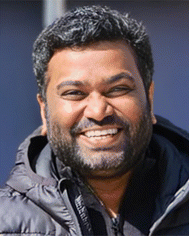 |
Sajesh P. Thomas earned his MSc in Chemistry from Mahatma Gandhi University, Kottayam and his Bachelor’s degree from Kasaragod Government College, Kerala. He completed his PhD in 2014 from the Indian Institute of Science, Bangalore, under the guidance of Prof. T. N. Guru Row, focusing on charge density and crystal engineering studies of pharmaceutical solids. Following his doctorate, he conducted postdoctoral research with Prof. Mark A. Spackman at the University of Western Australia, Perth, and later held a Marie-Curie fellowship with Prof. Bo B. Iversen at Aarhus University, Denmark. He is currently an Associate Professor in the Department of Chemistry at the Indian Institute of Technology Delhi, where he leads Materials and Quantum Crystallography Lab (MQCL). His research interests include quantum crystallography and crystal engineering of pharmaceutical solids and soft piezoelectric materials. |
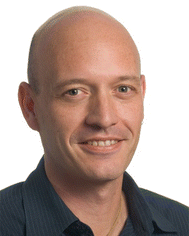 |
Professor John C. McMurtrie completed his BSc (Hons) at Macquarie University before moving to The University of New South Wales for his doctoral. He then completed a postdoctoral appointment at the University of Sydney (2003–2004). John was appointed Lecturer in Inorganic Chemistry at Queensland University of Technology in 2004 where he remains, now as a Professor of Inorganic Chemistry. |
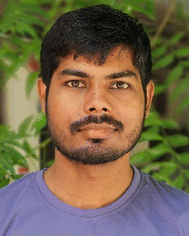 |
Atiqur Rahman received his BSc (Hons) in Chemistry from Kirori Mal College, University of Delhi and his MSc in Chemistry from Indian Institute of Technology Delhi. He is currently pursuing a joint PhD at IIT Delhi and The University of Queensland under the supervision of Professor Sajesh P. Thomas and Professor Jack K. Clegg. His doctoral research focuses on the structural origins of mechanical flexibility and piezoelectricity in molecular crystals, with an emphasis on structural perturbations induced by bending and high-pressure conditions, employing synchrotron-based micro-focused X-ray diffraction and high-pressure crystallographic techniques. |
Tutorial Reviews are normally invited by the Editorial Board, however suggestions are welcome and enquiries, along with a brief synopsis and author credentials, should be directed to the Editors-in-Chief at CrystEngComm-rsc@rsc.org. Readers may nominate themselves, or others, to write a Tutorial Review.
We hope you enjoy reading this Tutorial review* and if you haven’t already seen them please do read the previous tutorial reviews in our series: Useful practices in single crystal diffraction analysis of reticular structures by Stefano Canossa and The impact of crystal habit on the pharmaceutical properties of active pharmaceutical ingredients by Dinesh Kumar et al.
*Free to access until December 31st 2025.
Themed Collection: MOFs in Asia

We are delighted to share our latest themed collection: MOFs in Asia
This themed collection showcases the recent advances and innovative research in the field of Metal-Organic Frameworks across Asia, highlighting cutting-edge developments in their design, synthesis and application. The collection is guest-edited by Hoi Ri Moon (Ewha Womans University, Republic of Korea), Sarah S. Park (Pohang University of Science and Technology, Republic of Korea) and Jihye Park (University of Colorado Boulder, USA).
Browse a selection of some of the articles in the collection:
Editorial
| MOFs in Asia
Hoi Ri Moon, Sarah S. Park and Jihye Park CrystEngComm, 2025, 27, 6696-6696
|
 |
Highlight review articles
|
Recent multifunctional applications of AIE-MOF/COF porous materials Siwen Liu, Guijie Liang, Song Wang and Qingsong Hu
|
 |
| MOFs in healthcare diagnostics: shaping the future of biomedical test strips
Vibhav Shukla and Kafeel Ahmad Siddiqui CrystEngComm, 2025, 27, 4443-4452
|
 |
Communications
|
Efficient solvent-free mechanochemical synthesis of CALF-20 for carbon dioxide capture Natchaya Phongsuk, Chalarat Chaemchamrat, Taya Ko Saothayanun, Nopphon Weeranoppanant and Sareeya Bureekaew CrystEngComm, 2025, 27, 5959-5964
|
 |
|
Byoung Gwan Lee, Dongwook Kim, Jin Young Bae, Ji Woo Jeong and Dae-Woon Lim CrystEngComm, 2025, 27, 5952-5958
|
 |
Research Articles
|
Souvik Pal, Ling-I Hung, Wun-Jing Chen, Jiun-Jen Chen, Chun-Chuen Yang and Chia-Her Lin CrystEngComm, 2025, 27, 6295-6302
|
 |
|
Kazuaki Tachimoto, Kanokwan Jumtee Takeno and Rie Makiura CrystEngComm, 2025, 27, 5793-5802
|
 |
We hope you enjoy reading these articles along with the rest in the collection. The articles are all free to access until November 30th 2025.
Introducing Tutorial Reviews to CrystEngComm
We are delighted to introduce Tutorial Reviews as a new article type in CrystEngComm
CrystEngComm Tutorial Reviews were first commissioned in 2024 and are aimed at researchers who are new to the field or are embarking on a new direction of research, giving insight into how crystal engineering techniques underpin certain research areas.
They are focused on the application of crystal engineering techniques and should be comprehensive enough to be used for teaching purposes. They comment on best practice techniques for a given research methodology and how understanding crystal engineering can best serve researchers’ progress on a given topic.
Each Tutorial Review will include up to five ‘key learning points’ that a reader should expect to gain from reading the review.
See our most recent Tutorial Review by Stefano Canossa from ETH Zürich
| Useful practices in single crystal diffraction analysis of reticular structures
Stefano Canossa
CrystEngComm, 2025, 27, 6556-6571 |
 |
Key learning points in this Tutorial review:
1. Crystal structures are artificial simplifications of the non-periodic structure of real crystals. Nonetheless, these models are key enablers of scientific progress, if they maintain accuracy before precision in describing the average structure.
2. Steps such as sample preparation, data collection, data reduction, and structure modelling should be based on educated intentional choices. Default options provided by software or pre-made routines can be accepted only when their significance has been understood in the appropriate context.
3. Models can be only as reliable as the data allows for, and data can be only as good as the crystal allows for. Investing adequate care firstly on crystal selection, then on data collection and reduction, and ultimately on structure modelling, is a defining aspect of a crystallographer’s work.
4. The distinction between ‘data’, ‘information’ and ‘model’ — herewith provided — is necessary for a correct crystallographic practice and a scientifically rigorous representation of its results.
5. Standard diffraction data provide a wealth of information beyond the simple numerical values of integrated intensities. This information can be found in reciprocal space reconstructions and include aspects such as mosaicity, disorder, and defects.
Meet the author
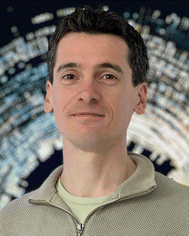 |
Stefano Canossa is a senior scientist with over a decade of experience in the crystallographic analysis of open-framework compounds using X-ray and electron diffraction. Trained as a coordination chemist, his crystallographic journey began during his MSc research on host–guest chemistry in metal–organic frameworks, and later expanded to include co-crystals, metal complexes, zeolites, and perovskites. Alongside crystal structure determination, his independent research explores the synthesis and characterization of correlated disorder in crystalline materials by leveraging on single crystal total scattering analysis in both real and reciprocal space. |
Tutorial Reviews are normally invited by the Editorial Board, however suggestions are welcome and enquiries, along with a brief synopsis and author credentials, should be directed to the Editors-in-Chief at CrystEngComm-rsc@rsc.org. Readers may nominate themselves, or others, to write a Tutorial Review.
We hope you enjoy reading this Tutorial review and keep an eye out for the next one in the series coming soon: Identifying and Characterising Flexible Crystals by Jack Clegg and colleagues.
We are delighted to announce the winner of the 2024 CrystEngComm Outstanding Paper Award
First launched in 2022, the Outstanding Paper Award is an award aimed at recognising the high-quality work published in CrystEngComm from the previous year, acknowledging the excellence of the paper as a whole and recognising the contributions of all the authors.
Congratulations to the winners of the 2024 CrystEngComm Outstanding Paper Award, as selected by the Editorial Board, for their work on Integration of a model-driven workflow into an industrial pharmaceutical facility: supporting process development of API crystallisation: Thomas Pickles, Vaclav Svoboda, Ivan Marziano, Cameron J. Brown and Alastair J. Florence
The authors presented a resource efficient yet scalable pharmaceutical crystallisation process development using a model-driven workflow.

Meet the authors of this Outstanding Paper
Thomas Pickles
 Thomas joined CMAC in October 2020 where he completed his PhD within the Florence Group with his thesis titled the “Intensification of a workflow for particle engineering and crystallisation process development”. After the completion of his PhD he worked in the pharmaceutical industry for Pfizer R&D UK before returning to CMAC in 2024 as a PDRA working on the core project “Automated model-based design of experiments for crystallisation process development”. More recently, Thomas has moved into a project research scientist role working on the multi-institutional and disciplinary collaborative project “Test Beds for MediForge – Industry 5.0 medicines manufacturing research hub”. The project integrates laboratory equipment for end-to-end synthesis, crystallisation, isolation, drying and drug product development with machine learning and automation. This project aims to reduce material usage and streamline development timelines for use in pharmaceutical manufacturing at the many gram scale.
Thomas joined CMAC in October 2020 where he completed his PhD within the Florence Group with his thesis titled the “Intensification of a workflow for particle engineering and crystallisation process development”. After the completion of his PhD he worked in the pharmaceutical industry for Pfizer R&D UK before returning to CMAC in 2024 as a PDRA working on the core project “Automated model-based design of experiments for crystallisation process development”. More recently, Thomas has moved into a project research scientist role working on the multi-institutional and disciplinary collaborative project “Test Beds for MediForge – Industry 5.0 medicines manufacturing research hub”. The project integrates laboratory equipment for end-to-end synthesis, crystallisation, isolation, drying and drug product development with machine learning and automation. This project aims to reduce material usage and streamline development timelines for use in pharmaceutical manufacturing at the many gram scale.
Vaclav Svoboda
 Vaclav Svoboda is a crystallization scientist at Pfizer with a PhD in chemical engineering from the University of Strathclyde. He develops processes for active pharmaceutical ingredients (APIs), collaborates across teams to scale up crystallizations and isolations to pilot and commercial scale. His research interests include continuous crystallization, wet milling, particle engineering, drying and process modelling. Vaclav has worked with both academia and industry to advance crystallization science for drug development.
Vaclav Svoboda is a crystallization scientist at Pfizer with a PhD in chemical engineering from the University of Strathclyde. He develops processes for active pharmaceutical ingredients (APIs), collaborates across teams to scale up crystallizations and isolations to pilot and commercial scale. His research interests include continuous crystallization, wet milling, particle engineering, drying and process modelling. Vaclav has worked with both academia and industry to advance crystallization science for drug development.
Ivan Marziano
 Despite not having yet fulfilled his childhood dream of acquiring superpowers through an experiment gone south, Ivan has enjoyed a successful 25+ year career as a pharmaceutical chemist. An internationally recognised leader in crystallization, he has contributed to the launch of many new medicines and the introduction of novel technologies, and is now serving as CSIO of Particology, a Kent-based contract research organisation. Ivan is also passionate about DEI, with his endeavours recognised with a 2024 WISE (Women in Science and Engineering) Ally Award. Outside of work, when he is not busy polishing his RSC Fellowship certificate, Ivan is an avid music fan.
Despite not having yet fulfilled his childhood dream of acquiring superpowers through an experiment gone south, Ivan has enjoyed a successful 25+ year career as a pharmaceutical chemist. An internationally recognised leader in crystallization, he has contributed to the launch of many new medicines and the introduction of novel technologies, and is now serving as CSIO of Particology, a Kent-based contract research organisation. Ivan is also passionate about DEI, with his endeavours recognised with a 2024 WISE (Women in Science and Engineering) Ally Award. Outside of work, when he is not busy polishing his RSC Fellowship certificate, Ivan is an avid music fan.
Cameron J. Brown
 Cameron is a Reader in Digital Pharmaceutical Manufacturing for the Strathclyde Institute of Pharmacy and Biomedical Sciences at the University of Strathclyde, Glasgow. Specialising in the development of digital design tools and strategies for pharmaceutical manufacturing. He is a Chemical Engineering graduate of Heriot-Watt University, where he also obtained his PhD in the characterisation of crystallisation processes. He joined Strathclyde University in 2014 and has been through many roles as research associate, research fellow, and Chancellor’s fellow. Currently a member of the Acceleration Consortium and committee member of the British Association of Crystal Growth. His current research is focused on the development and application of modelling approaches for pharmaceutical manufacturing, including GenAI, self-driving labs, hybrid physics/data approaches. Currently principal investigator for PharmaCrystNet and co-investigator on the MediForge: Industry 5.0 Medicines Manufacturing Hub and Digital Design and Manufacturing of Amorphous Pharmaceuticals. Knowledge exchange activities include pre-competitive and one-to-one projects with the leading pharmaceutical companies as well as knowledge transfer partnerships. Currently, Cameron co-ordinates and delivers the Drug Substance Manufacturing module as part of the Advanced Pharmaceuticals Manufacturing MSc course at the University of Strathclyde.
Cameron is a Reader in Digital Pharmaceutical Manufacturing for the Strathclyde Institute of Pharmacy and Biomedical Sciences at the University of Strathclyde, Glasgow. Specialising in the development of digital design tools and strategies for pharmaceutical manufacturing. He is a Chemical Engineering graduate of Heriot-Watt University, where he also obtained his PhD in the characterisation of crystallisation processes. He joined Strathclyde University in 2014 and has been through many roles as research associate, research fellow, and Chancellor’s fellow. Currently a member of the Acceleration Consortium and committee member of the British Association of Crystal Growth. His current research is focused on the development and application of modelling approaches for pharmaceutical manufacturing, including GenAI, self-driving labs, hybrid physics/data approaches. Currently principal investigator for PharmaCrystNet and co-investigator on the MediForge: Industry 5.0 Medicines Manufacturing Hub and Digital Design and Manufacturing of Amorphous Pharmaceuticals. Knowledge exchange activities include pre-competitive and one-to-one projects with the leading pharmaceutical companies as well as knowledge transfer partnerships. Currently, Cameron co-ordinates and delivers the Drug Substance Manufacturing module as part of the Advanced Pharmaceuticals Manufacturing MSc course at the University of Strathclyde.
Alastair J. Florence
 Alastair Florence is a distinguished professor in pharmaceutical sciences at the University of Strathclyde and is Director of CMAC, providing leadership across the portfolio, engaging with key stakeholders, and driving the centre’s vision to transform the development and manufacture of medicines. Alastair leads a number of major programs across the portfolio including the new flagship EPSRC MediForge Industry 5.0 Manufacturing Hub, Centre for Doctoral Training in Cyber-physical systems (CEDAR) and the £33M UK-RPIF funded CMAC Data Lab partnership. He leads the multidisciplinary, multi-institution academic team driving ambitious manufacturing research, training, translation and facilities programs and working in close collaboration with industry partners to understand challenges and develop effective solutions across CMAC programs. His research interests lie in the science and technology associated with continuous crystallization, physical form control and advanced characterization of pharmaceutical materials and the development of digital technologies to transform the development and manufacture of medicines.
Alastair Florence is a distinguished professor in pharmaceutical sciences at the University of Strathclyde and is Director of CMAC, providing leadership across the portfolio, engaging with key stakeholders, and driving the centre’s vision to transform the development and manufacture of medicines. Alastair leads a number of major programs across the portfolio including the new flagship EPSRC MediForge Industry 5.0 Manufacturing Hub, Centre for Doctoral Training in Cyber-physical systems (CEDAR) and the £33M UK-RPIF funded CMAC Data Lab partnership. He leads the multidisciplinary, multi-institution academic team driving ambitious manufacturing research, training, translation and facilities programs and working in close collaboration with industry partners to understand challenges and develop effective solutions across CMAC programs. His research interests lie in the science and technology associated with continuous crystallization, physical form control and advanced characterization of pharmaceutical materials and the development of digital technologies to transform the development and manufacture of medicines.
Read the full outstanding article:
| Integration of a model-driven workflow into an industrial pharmaceutical facility: supporting process development of API crystallisation
Thomas Pickles, Vaclav Svoboda, Ivan Marziano, Cameron J. Brown and Alastair J. Florence CrystEngComm, 2024, 26, 4678-4689 |
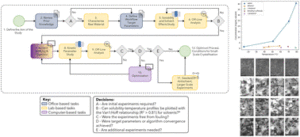 |
Please join us in congratulating this year’s winners!
Welcoming Sharmarke Mohamed and Ghazala Sadiq to the CrystEngComm Editorial Board

We are delighted to introduce Professor Sharmarke Mohamed (Khalifa University of Science and Technology, UAE) and Dr Ghazala Sadiq (The Cambridge Crystallographic Data Centre, UK) as the latest members of the CrystEngComm Editorial Board!

Professor Sharmarke Mohamed
(ORCiD 0000-0002-5195-2533)
Sharmarke Mohamed is an Associate Professor of Chemistry at Khalifa University (KU), acting as Principal Investigator in the Green Chemistry & Materials Modelling Laboratory. He founded and currently heads the KU Chemical Crystallography Laboratory, offering crystallographic services to KU researchers while forging new collaborations with premier global labs in solid-state chemistry. He also holds the role of Theme Leader for the Center for Catalysis and Separations (CeCaS). Sharmarke graduated with a First Class MSci in Chemistry (2007) and PhD in Chemistry (2011) degrees from University College London, mentored by Prof. Sarah (Sally) L. Price FRS and Prof. Derek A. Tocher. His research, spanning chemical crystallography, computational chemistry, and green chemistry, is reflected in over 70 publications and three patents. At CrystEngComm, Sharmarke oversees the commissioning of computational chemistry manuscripts, striving to elevate the journal’s presence in the Middle East and Asia. Sharmarke joined the Editorial Board in 2025, following service on the Editorial Advisory Board of the journal since 2021, and was honored to be recognized as an Outstanding Reviewer in 2019 for his rigorous and timely reviews for the journal. His brief stint in the pharmaceutical industry led to intellectual property on novel solid forms of generic drugs and contributed to the current U.S. Food and Drug Administration’s guidance of what constitutes a “pharmaceutical cocrystal”.
Sharmarke’s service to the UAE chemical sciences community is extensive. He co-founded the Emirates Crystallographic Society in 2020, acting as Vice President and UAE Councillor to the European Crystallographic Association. As Chair of the American Chemical Society (ACS) UAE Chapter (2023–2024), Sharmarke oversaw a 55% increase in ACS membership from the UAE. He also established KU’s first ACS International Student Chapter in 2022, mentoring a senior chemistry student to become the UAE’s sole COP28 ACS Ambassador in 2023.
Beyond his academic pursuits, Sharmarke cherishes time with his two boys, tries to hone his multilingual skills, enjoys playing padel and seizes opportunities to travel and learn new cultures, whenever the opportunity presents itself.
Sharmarke has given his thoughts on working with the RSC and on the Editorial Board of CrystEngComm in particular:
“The RSC is home to some of the best journals in chemistry and it is my pleasure to be a part of the Editorial Board of CrystEngComm, where I hope to contribute to expanding the reach and visibility of the journal in the Middle East and Asia.”
 Dr Ghazala Sadiq
Dr Ghazala Sadiq
(ORCiD 0000-0001-6638-8464)
Ghazala is part of the Scientific Leadership Team at the CCDC. Ghazala manages the Pfizer Solid Form Design Centre Team where part of her role includes applying the latest knowledge-based informatics techniques to drug development compounds. Ghazala also leads the Crystal Form Consortium, a collaborative venture bringing together scientists from major pharmaceutical industries around the world. Working to leverage the vast wealth of structural knowledge in the CSD, the Consortium’s primary goal is to provide structural informatics tools and insights to address challenges relating to polymorphism, stability, and solid form selection during different stages of the drug development process. She has a keen interest in Crystal Engineering, covering a range of topics including polymorphism, co-crystal design, fundamentals of intermolecular interactions, crystallisation, and the importance of molecular self-assembly in the nucleation of crystalline phases.
Ghazala’s thoughts on working with the RSC on the Editorial Board of CrystEngComm:
“It’s a real privilege to join the CrystEngComm editorial board. The journal plays a key role in advancing crystal engineering, and I look forward to working with the RSC to help shape its continued success”.
Highlights of 2024 from CrystEngComm

Happy new year from the CrystEngComm editorial team!
What a year 2024 has been! CrystEngComm published its 26th volume with over 670 articles in issues, 23 Highlight review articles and 60 Communications, from 47 countries. In total across the year, we published 112 HOT, reviewer recommended articles which included 11 Communications and nine Highlight review articles. Read the last quarter’s HOT articles in this collection.
We are delighted to share some further highlights of CrystEngComm in 2024, including our Outstanding Paper Award winners, the introduction of our cover collection and cover gallery, and our most popular articles from the year.
Editorial board
At the end of January, we were delighted to announce that Christian Doonan (University of Adelaide, Australia) and C. Malla Reddy (Indian Institute of Technology, Hyderabad, India) had been appointed as Co-Editors-in-Chief of CrystEngComm. They succeeded Pierangelo Metrangolo who served as the journal’s Chair for six years.
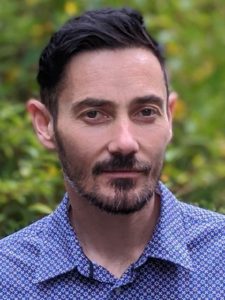 Christian Doonan is a Professor of Chemistry and a South Australian Government Future Industry Making Fellow at the University of Adelaide. He received his PhD at the University of Melbourne and carried out post-doctoral work with Professor Omar Yaghi at the University of California, Los Angeles. His research group focuses on the design and synthesis of Metal-organic Framework materials for application to biotechnology and catalysis.Christian is a member of the international MOF commission and his research has been recognised through several awards including, an Australian Research Council Future Fellowship and a distinguished lectureship award from the Chemical Society of Japan.
Christian Doonan is a Professor of Chemistry and a South Australian Government Future Industry Making Fellow at the University of Adelaide. He received his PhD at the University of Melbourne and carried out post-doctoral work with Professor Omar Yaghi at the University of California, Los Angeles. His research group focuses on the design and synthesis of Metal-organic Framework materials for application to biotechnology and catalysis.Christian is a member of the international MOF commission and his research has been recognised through several awards including, an Australian Research Council Future Fellowship and a distinguished lectureship award from the Chemical Society of Japan.
C Ma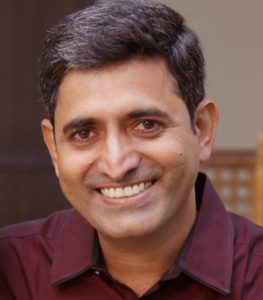 lla Reddy is a Professor in the Department of Chemistry at the Indian Institute of Technology Hyderabad (IITH), India. He obtained his PhD in Crystal Engineering from the School of Chemistry, University of Hyderabad (2001-2006) and carried out postdoctoral work at Karlsruhe Institute of Technology, Germany (2007-2008). He established an independent group at the Indian Institute of Science Education and Research (IISER) Kolkata in 2008 and continued there until he moved to IITH in 2023. He had been an Honorary Visiting Scientist to the University of Bradford (2015-18) and a recipient of the Royal Society of Chemistry’s Mobility Grant, Distinguished Lectureship Award from the Chemical Society of Japan (2017) and Swarnajayanti Fellowship from the Department of Science and Technology, India. His research group is engaged in understanding the mechanical properties of organic solids, including pharmaceutical and optoelectronic crystals. Some of his well-known contributions include the discovery of flexible elastic and plastic organic crystals, designing flexible crystals using Supramolecular Shape Synthons, etc. He has published over 90 research articles.
lla Reddy is a Professor in the Department of Chemistry at the Indian Institute of Technology Hyderabad (IITH), India. He obtained his PhD in Crystal Engineering from the School of Chemistry, University of Hyderabad (2001-2006) and carried out postdoctoral work at Karlsruhe Institute of Technology, Germany (2007-2008). He established an independent group at the Indian Institute of Science Education and Research (IISER) Kolkata in 2008 and continued there until he moved to IITH in 2023. He had been an Honorary Visiting Scientist to the University of Bradford (2015-18) and a recipient of the Royal Society of Chemistry’s Mobility Grant, Distinguished Lectureship Award from the Chemical Society of Japan (2017) and Swarnajayanti Fellowship from the Department of Science and Technology, India. His research group is engaged in understanding the mechanical properties of organic solids, including pharmaceutical and optoelectronic crystals. Some of his well-known contributions include the discovery of flexible elastic and plastic organic crystals, designing flexible crystals using Supramolecular Shape Synthons, etc. He has published over 90 research articles.
CrystEngComm journal covers
We published 44 covers supplied by authors in 2024, and introduced the Articles behind the 2024 journal covers collection as well as the CrystEngComm cover gallery, ensuring great visibility of both the covers and associated articles.
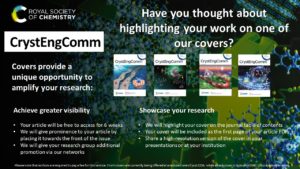
CrystEngComm Outstanding Paper Award
The Outstanding Paper Award is an award aimed at recognising the high-quality work published in CrystEngComm from the previous year, acknowledging the excellence of the paper as a whole and recognising the contributions of all the authors.
The winners of the CrystEngComm Outstanding Paper Award 2023 are Hunter J. Windsor, Cameron J. Kepert and Lauren K. Macreadie, for their work: ‘Spontaneous resolution of two chiral metal–organic frameworks through local geometric and lattice frustration effects’.
| Spontaneous resolution of two chiral metal–organic frameworks through local geometric and lattice frustration effects
Hunter J. Windsor, Cameron J. Kepert and Lauren K. Macreadie* CrystEngComm, 2023, 25, 5428-5435 |
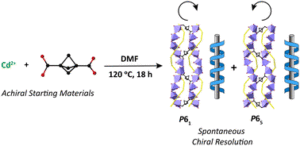 |
The authors presented two chiral metal–organic frameworks that are differentiated by their Cd-centred helical twists and are prepared by spontaneous chiral resolution from rigid, aliphatic, and achiral precursors. Read the winning article here.
Transparent peer review
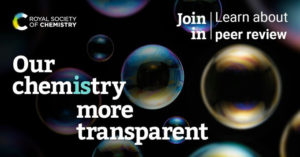
The RSC launched transparent peer review across its portfolio in 2024.
In the interest of transparency and open science CrystEngComm offers authors the option of transparent peer review, where the editor’s decision letter, reviewers’ comments and authors’ response for all versions of the manuscript are published alongside the article. To find out more about transparent peer review Watch our video.
Most popular articles in 2024
In 2024 our articles received an average of 120 downloads within 90 days of being published, highlighting the excellent visibility your article receives. We are pleased to share a selection of these most popular articles which are all free to access until 30th April 2025.
| Impurity retention and pharmaceutical solid solutions: visualizing the effect of impurities on dissolution and growth using dyed crystals
Anne Nong, Claire Schleper, Abigail Martin, Mitchell Paolello, Fredrik L. Nordstrom and Gerard Capellades CrystEngComm, 2024, 26, 5337-5350 |
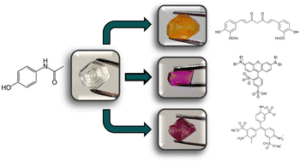 |
| Utilizing 3-methyl-1-butene co-units to tailor phase transition behavior in butene-1 copolymers
Jiazheng Shen, Wei Li, Ruijun Zhao, Yingzhuo Liu and Zhe Ma CrystEngComm, 2024, 26, 51-60 |
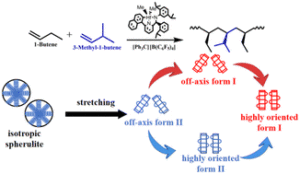 |
| Project M: investigating the effect of additives on calcium carbonate crystallisation through a school citizen science program
Claire A. Murray, Project M Scientists, Laura Holland, Rebecca O’Brien, Alice Richards, Annabelle R. Baker, Mark Basham, David Bond, Leigh D. Connor, Sarah J. Day, Jacob Filik, Stuart Fisher, Peter Holloway, Karl Levik, Ronaldo Mercado, Jonathan Potter, Chiu C. Tang, Stephen P. Thompson and Julia E. Parker CrystEngComm, 2024, 26, 753-763 |
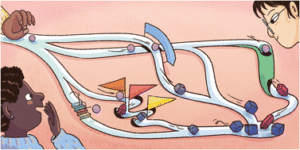 |
We would love you to be part of the future of CrystEngComm so on behalf of the Co-Editors-in-Chief of CrystEngComm, Professors Christian Doonan and C. Malla Reddy, we invite you to submit your research to CrystEngComm. See our author guidelines for information on our article types or find out more about the advantages of publishing in a Royal Society of Chemistry journal.
From all the CrystEngComm team, we thank you for your continued interest in and support of the journal and wish you well for 2025!
CrystEngComm 2024 Cover Gallery
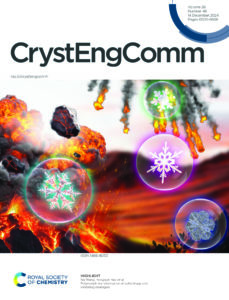 |
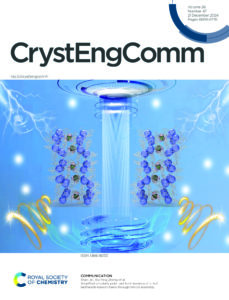 |
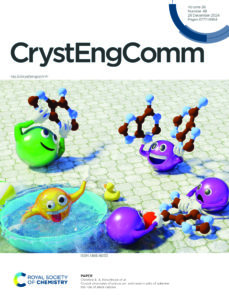 |
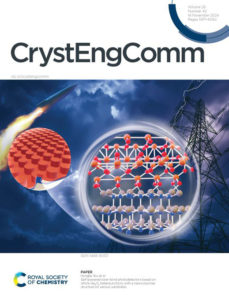 |
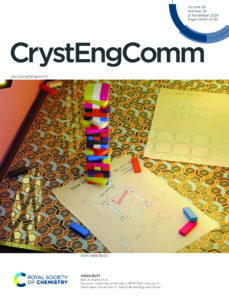 |
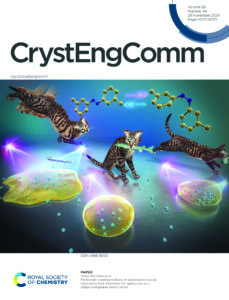 |
|
Issue 42– Inside Front Cover |
||
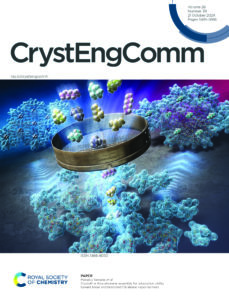 |
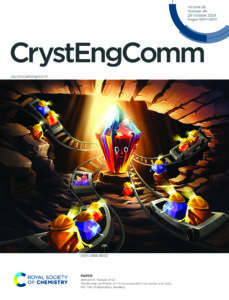 |
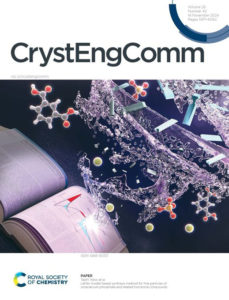 |
| Issue 42 – Outside Front Cover | ||
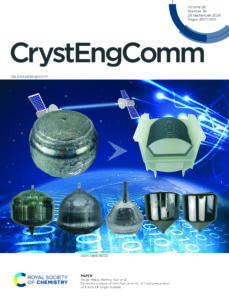 |
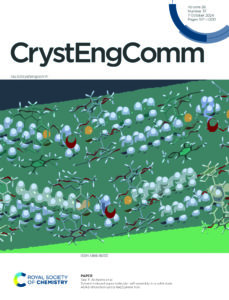 |
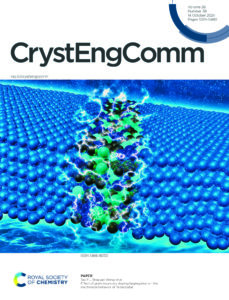 |
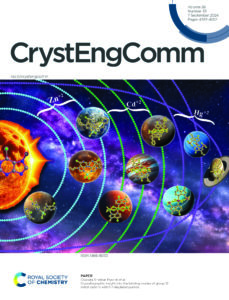 |
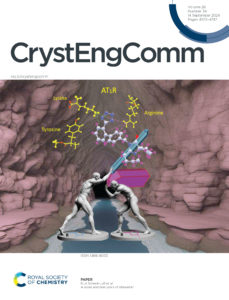 |
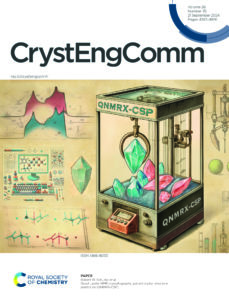 |
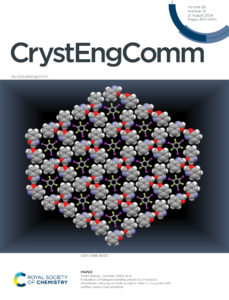 |
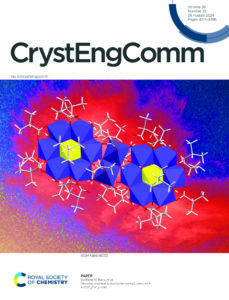 |
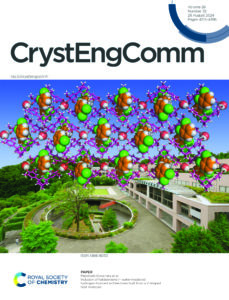 |
| Issue 31 – Inside Front Cover |
Issue 32 – Outside Front Cover |
Issue 32 – Inside Front Cover |
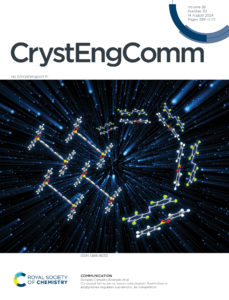 |
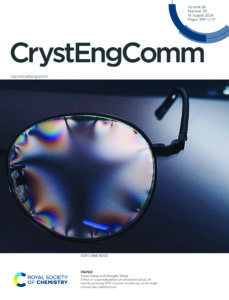 |
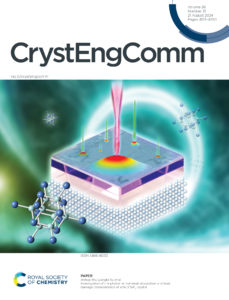 |
|
Issue 30 – Outside Front Cover |
Issue 30 – Inside Front Cover |
Issue 31 – Outside Front Cover |
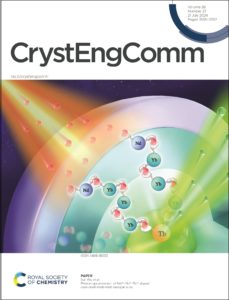 |
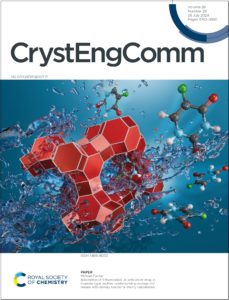 |
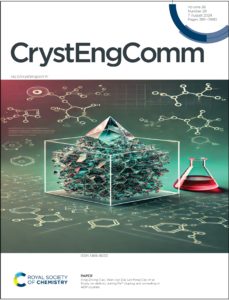 |
 |
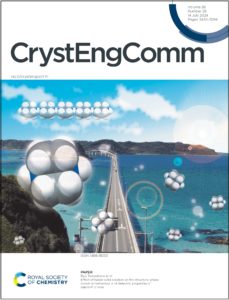 |
 |
| Issue 26 | ||
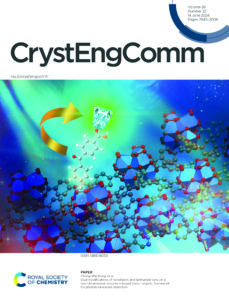 |
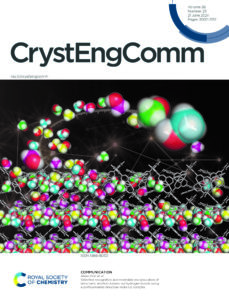 |
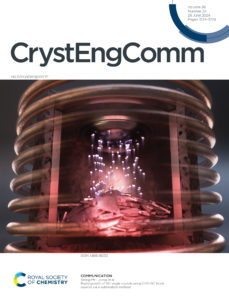 |
 |
 |
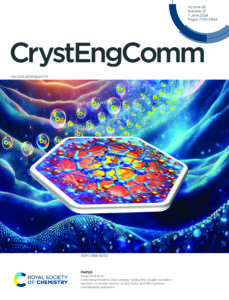 |
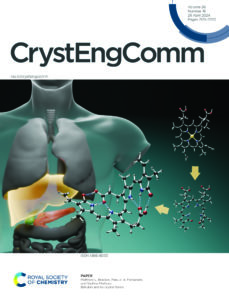 |
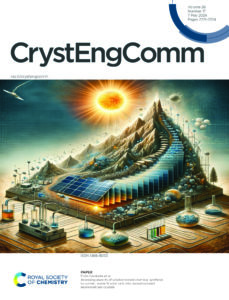 |
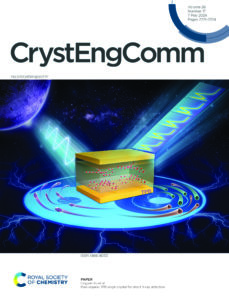 |
| Issue 16 | Issue 17 | Issue 17 |
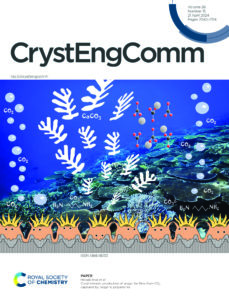 |
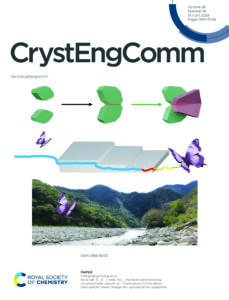 |
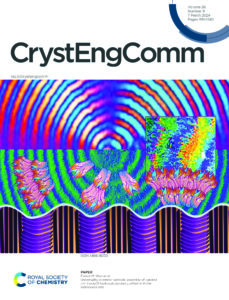 |
| Issue 15 | Issue 14 | Issue 9 |
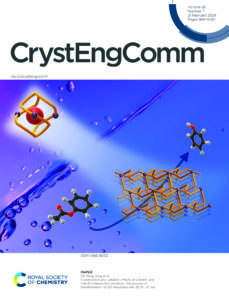 |
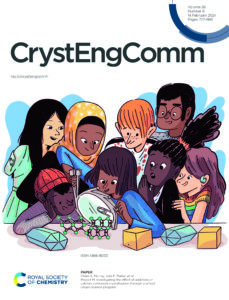 |
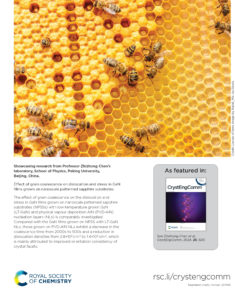 |
| Issue 7 | Issue 6 | Issue 5 |
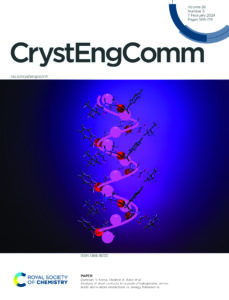 |
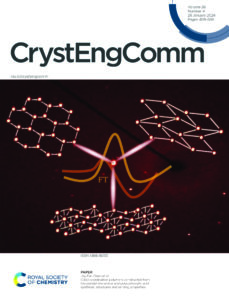 |
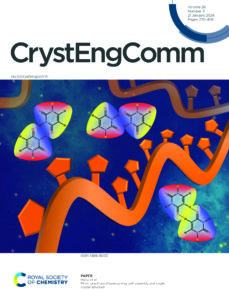 |
| Issue 5 | Issue 4 | Issue 3 |
CrystEngComm Outstanding Paper Award, 2023
We are delighted to announce the winner of the CrystEngComm Outstanding Paper Award, 2023!
First launched in 2022, the Outstanding Paper Award is an award aimed at recognising the high-quality work published in CrystEngComm from the previous year, acknowledging the excellence of the paper as a whole and recognising the contributions of all the authors.
Congratulations to the winners of the CrystEngComm Outstanding Paper Award 2023, as selected by the Editorial Board, for their work on Spontaneous resolution of two chiral metal–organic frameworks through local geometric and lattice frustration effects: Hunter J. Windsor, Cameron J. Kepert and Lauren K. Macreadie.
The authors presented two chiral metal–organic frameworks that are differentiated by their Cd-centred helical twists and are prepared by spontaneous chiral resolution from rigid, aliphatic, and achiral precursors.
Read the full outstanding article:
Meet the authors of this Outstanding Paper
Hunter J. Windsor
 Hunter Windsor received his PhD in chemistry in 2022 from the University of Sydney. His research involved exploring spin crossover metal–organic frameworks and modulation of their magnetic properties through guest confinement. He is currently a postdoctoral research associate for Professor Les Field at the University of New South Wales where he is investigating the reactivity of small molecules such as carbon dioxide and acetylene with ruthenium-centred organometallic complexes. Hunter is passionate about teaching crystallography and is interested in developing new methods for crystallising reactive species that have otherwise eluded characterisation.
Hunter Windsor received his PhD in chemistry in 2022 from the University of Sydney. His research involved exploring spin crossover metal–organic frameworks and modulation of their magnetic properties through guest confinement. He is currently a postdoctoral research associate for Professor Les Field at the University of New South Wales where he is investigating the reactivity of small molecules such as carbon dioxide and acetylene with ruthenium-centred organometallic complexes. Hunter is passionate about teaching crystallography and is interested in developing new methods for crystallising reactive species that have otherwise eluded characterisation.
Cameron Kepert is a Professor in the School of Chemistry at the University of Sydney. He received his B.Sc. (Hons) from the University of Western Australia, PhD from the Royal Institution of Great Britain/University of London and was a Junior Research Fellow at the University of Oxford from 1995-1998. He is a recipient of the Australian Prime Minister’s Prize for Physical Scientist of the Year, the Le Fèvre Memorial Prize of the Australian Academy of Science, the Burrows Award and Rennie Medal of the Royal Australian Chemical Institute. His research interests include nanoporous metal—organic framework materials, spin-crossover, molecular magnets, molecular conductors, and negative thermal expansion materials.
Lauren K. Macreadie
Dr Lauren Macreadie is an ARC DECRA fellow and a UNSW Scientia Fellow at the University of New South Wales and investigates how porous materials can be used to solve our key energy questions around hydrogen storage and transport, and chemical separations. Following the completion of her PhD at the CSIRO and Monash University in 2016, she worked at Trinity College in Dublin, Ireland, on water splitting MOF systems, followed by research with the CSIRO in Melbourne on MOFs as adsorbents for respiratory canisters with the Defense Science and Technology group. Lauren then became a lecturer at Massey University in New Zealand in 2020. In 2021 she began her DECRA fellowship at the University of Sydney and moved to UNSW in 2022.
Please join us in congratulating this year’s winners!
The Articles behind the covers
We are delighted to share with you our latest collection showcasing the articles behind the 2024 CrystEngComm covers.
This latest collection of recently published articles brings together all the cover articles published so far this year, which showcases the wide range of research found in the journal. Further articles will be added to this collection as they are published.
Here is a selection of some of the articles in the collection:
| Nitro group and K+-based secondary building units for the self-assembly of 3D coordination polymers built on dinuclear dianionic helicate connectors
Raúl Mendoza-Báez, Alan Molina-Renteria and Juan Olguín CrystEngComm, 2024, 26, 2346-2352 |
 Outside front cover of issue 18 Outside front cover of issue 18 |
| Pure organic TPB single crystal for direct X-ray detection
Kai Jiang, Lingyan Xu, Rongjin Shang, Lu Liang, Yingming Wang, Zhentao Qin and Wanqi Jie CrystEngComm, 2024, 26, 2241-2247 |
|
| Effect of grain coalescence on dislocation and stress in GaN films grown on nanoscale patterned sapphire substrates
Zuojian Pan, Zhizhong Chen, Yiyong Chen, Haodong Zhang, Han Yang, Ling Hu, Xiangning Kang, Ye Yuan, Chuanyu Jia, Zhiwen Liang, Qi Wang, Guoyi Zhang and Bo Shen CrystEngComm, 2024,26, 620-630 |
We hope you enjoy these articles and the rest in the collection. Read these articles for free until 15th July 2024.
Have you thought about highlighting your work on one of our covers? *
Covers provide a unique opportunity to amplify your research:
Achieve greater visibility:
- Your article will be free to access for 6 weeks.
- We will give prominence to your article in the issue.
- We will give your research group additional promotion via our networks.
- We will include your article in the covers collection and in the cover gallery on our blog.
Showcase your research:
- We will highlight your cover on the journal table of contents.
- Your cover is included as the first page of your article PDF.
- We will share a high-resolution version of the cover for you to use in presentations or display at your institution.
If you are interested in showcasing your research on one of our covers, once your article has been accepted for publication please do contact the Editorial Team for further information: Crystengcomm@rsc.org
* Please note that authors are required to pay a fee for this service. Front covers are currently being offered at a reduced rate of just £250, while a back cover is typically £1000 (plus applicable taxes).















